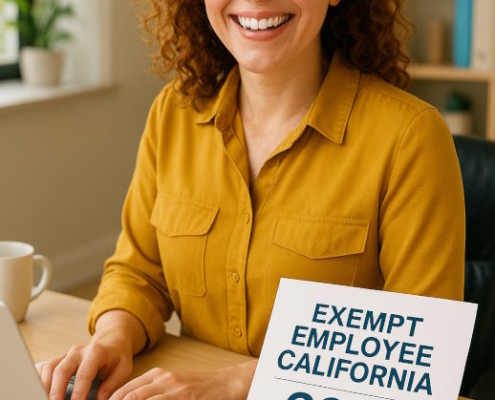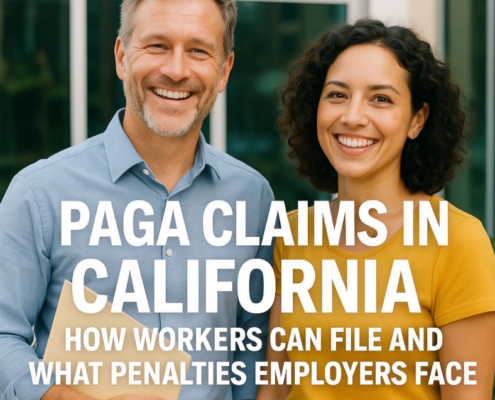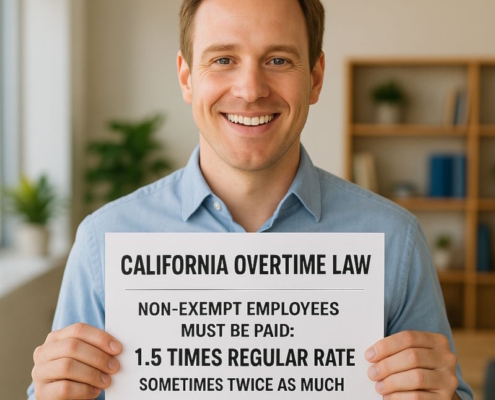Meal Period PAGA Penalties: PAGA Penalties for Missed Meal Breaks
For every missed meal break, the employer must pay the employee one-hour premium pay. Also, when the premium pay was not paid, the employer must pay waiting time penalties equal to a day’s wages for each day the final pay is not provided to the employee, up to a maximum of 30 days.
Updated: 05/19/2023
By Douglas Wade, Attorney
Email | Call (800) 484-4610
Meal Period Law
Cal. Lab. Code. § 512(a) (“An employer may not employ an employee for a work period of more than five hours per day without providing the employee with a meal period of not less than 30 minutes, except that if the total work period per day of the employee is no more than six hours, the meal period may be waived by mutual consent of both the employer and employee. An employer may not employ an employee for a work period of more than 10 hours per day without providing the employee with a second meal period of not less than 30 minutes, except that if the total hours worked is no more than 12 hours, the second meal period may be waived by mutual consent of the employer and the employee only if the first meal period was not waived.”).
In this article, our attorney defending PAGA lawsuit for companies and employers discusses PAGA penalties for missed meal period as follows:
Missed Meal Period Law
California Labor Code Section 226.7(c) provides, “[i]f an employer fails to provide an employee a meal or rest or recovery period in accordance with a state law, including, but not limited to, an applicable statute or applicable regulation, standard, or order of the Industrial Welfare Commission, the Occupational Safety and Health Standards Board, or the Division of Occupational Safety and Health, the employer shall pay the employee one additional hour of pay at the employee’s regular rate of compensation for each workday that the meal or rest or recovery period is not provided.” Cal. Lab. Code § 226.7(c).
Cal. Lab. Code. § 226.7(b) (“An employer shall not require an employee to work during a meal or rest or recovery period mandated pursuant to an applicable statute, or applicable regulation, standard, or order of the Industrial [*3] Welfare Commission, the Occupational Safety and Health Standards Board, or the Division of Occupational Safety and Health.”).
PAGA Penalty
PAGA Penalties are Properly Assessed at One Hundred Dollars For Each Aggrieved Employee Per Pay Period Prior to the Filing of Lawsuit. PAGA provides civil penalties for violations of the Labor Code. Cal. Lab. Code § 2699(a) (emphasis added).
- “[T]he civil penalty is one hundred dollars ($100) for each aggrieved employee per pay period for the initial violation
- two hundred dollars ($200) for each aggrieved employee per pay period for each subsequent violation.” Cal. Lab. Code § 2699(f)(2)
For the purposes of this order, “PAGA penalties” refers to the civil penalties that PAGA allows aggrieved employees to recover on behalf of the Labor and Workforce Development Agency, which were previously only recoverable by the LWDA. In the California Labor Code, penalties recoverable by or on behalf of the Labor and Workforce Development agency are referred to as “civil penalties.” See, e.g., Cal. Lab. Code § 2699(a). The California Supreme Court similarly refers to these penalties as “civil penalties.” “Statutory penalties,” however, exclusively refers to those penalties recoverable by individual employees directly under the Labor Code, which were recoverable before the PAGA’s enactment. See, e.g., Cal. Lab. Code § 226.7(c).
Under PAGA, aggrieved employees may bring civil actions personally and [*8] on behalf of other aggrieved employees to recover civil penalties that were previously recoverable only by the Labor and Workforce Development Agency (“LWDA”). Cal. Lab. Code § 2699(a); see Iskanian v. CLS Transp. Los Angeles, LLC, 59 Cal. 4th 348, 378-82, 173 Cal. Rptr. 3d 289, 327 P.3d 129 (2014). When aggrieved employees recover PAGA penalties, 75% of the recovered amount is distributed to the LWDA and 25% is distributed to the aggrieved employees. Cal. Lab. Code § 2699(i). These penalties available under PAGA are separate and distinct from the statutory penalties provided under other sections of the California Labor Code. Iskanian, 59 Cal. 4th at 381. Accordingly, employees may recover both statutory penalties and PAGA penalties for a Labor Code violation.3Link to the text of the note See id.; Caliber Bodyworks, Inc. v. Superior Court, 134 Cal. App. 4th 365, 377-88, 36 Cal. Rptr. 3d 31 (2005).
Awarding PAGA Penalties Would Not Constitute Double Recovery
Labor Code section No. 226.7(c) states:
If an employer fails to provide an employee a meal or rest or recovery period in accordance with a state law, including, but not limited to, an applicable statute or applicable regulation, standard, or order of the Industrial Welfare Commission, the Occupational Safety and Health Standards Board, or the Division of Occupational Safety and Health, the employer shall pay the employee one additional hour of pay at the employee’s regular rate of compensation for each workday that the meal or rest or recovery period is not provided.
The damages awarded by the jury to the Underpaid Meal Premium Class were for failure to provide a full thirty minute meal period. The Labor Code provides that due to the failure to provide the full thirty minute [*23] meal period, the employer must pay the employee one additional hour of compensation. Since the Labor Code provides that employees were entitled to one hour of pay at the employee’s regular rate of compensation for each workday a meal period was not provided, Defendants did not comply with California law by only paying one half hour of compensation. The damages sought for PAGA by the Underpaid Meal Premium Class are for the failure to pay a full hour of pay to aggrieved employees. The Court finds that awarding PAGA claims here would not be double recovery.
Statute of Limitation
Payment imposed for impermissibly failing to provide a meal or rest break was a penalty under Lab C § 226.7(b) and thus had to be raised within one year of the last date the claim accrued under CCP § 340. That limitation period expired before an employer requested an appeal and before an employee first raised it at the de novo trial of the wage claim, in violation of Lab C § 98.2. Murphy v. Kenneth Cole Productions, Inc. (Cal. App. 1st Dist. 2005), 134 Cal. App. 4th 728.
Preemption
Employee’s right to meal periods applied to signatories of collective bargaining agreements (CBA) and constituted a nonnegotiable right under California state law. Because the employees based their meal period claim on the protections afforded them by California state law, Lab C §§ 219, 226.7, and 512, without any reference to expectations or duties created by their CBA, the claim was not subject to preemption under § 301 (29 USCS § 185) of the Labor Management Relations Act, and the court lacked federal question jurisdiction over it under 28 USCS § 1331. Valles v. Ivy Hill Corp. (9th Cir. Cal. 2005), 410 F.3d 1071.
Public Employees
In a class action by the recognized employee organization for state employees in State Bargaining Unit 6 against the State and the California Department of Corrections and Rehabilitation, which alleged, among other things, violations of Lab C §§ 226.7 and 512, the organization’s argument that § 512 provided evidence that the legislature intended to include public entities was contrary to an established rule that had been recognized by the legislature, i.e., that public entities were not subject to a general statute unless expressly included, and the organization also could not rely on Lab C § 512.5, because the statute does not indicate a legislative intent to automatically apply § 512 and California Industrial Welfare Commission wage orders to public employers. Accordingly, the trial court did not err in ruling that §§ 226.7 and 512 did not apply to public employers like the State. California Correctional Peace Officers’ Assn. v. State of California (Cal. App. 1st Dist. 2010), 188 Cal. App. 4th 646.
Class Action
Interpretation of Lab C § 226.7 and Lab C § 512(a) as requiring employers to make a meal period available rather than ensuring that a period was taken foreclosed class-wide adjudication of employees’ claims under Fed. R. Civ. P. 23(a)(2) and (b)(3) because individual issues predominated; liability could not be established without individual trials for each class member to determine why each class member did not clock out for a full 30-minute meal break on any particular day. Salazar v. Avis Budget Group, Inc. (S.D. Cal. 2008), 251 F.R.D. 529, 2008 U.S. Dist. LEXIS 51620.
Remedies
Court is not bound by and rejects the reasoning of the California Department of Industrial Relations, Division of Labor Standards Enforcement, which has stated, with regard to a proposed amendment to 8 Cal Code Reg § 137000, that Lab C § 226.7 is penal in nature. Remedy claims can be asserted under Lab C § 226.7 in suits brought pursuant to California’s Unfair Competition Law (UCL), B & P C §§ 17200 et seq., because: (1) plaintiffs filing suits under the UCL are entitled to recover restitutional damages; and (2) Lab C § 226.7 is restitutional in nature. Tomlinson v. Indymac Bank, F.S.B. (C.D. Cal. 2005), 359 F. Supp. 2d 891.
Example Calculation 1:
Dr. Kriegler calculated the meal exception claim damages under Plaintiffs’ two theories of liability. First, Dr. Kriegler calculated damages for those employees who had meal exceptions coded in EMS as 1, 5, or 12 (“Theory 1”). Ex. 201-7. The three relevant codes are: code 1 (associate initiated customer support); code 5 (manager directed, no coverage for customer support); and code 12 (management directed). Tr. at 276:18-21; id. at 360:22-24; id. at 361:8-17. Second, Dr. Kriegler calculated damages for employees who had meal exceptions coded as 5 or 12 (“Theory 2”), but not 1. Ex. 201-7.
[*1071] For the calculation of principal damages under both theories of liability, Dr. Kriegler first looked in the data for meal exceptions coded as 1, 5, or 12 (or alternatively, 5 or 12 under Theory 2). Tr. at 470:17-22. Then, Dr. Kriegler looked at the MyShare data, which showed the non-discretionary bonus amounts, covering the period that included the meal exceptions. Id. Using these two pieces of information, Dr. Kriegler gave an example of how he did the calculation:
So, for instance, if there was a meal exception on February 1, 2013, and there was a quarterly bonus going from January 1, 2013, [**12] through March 31, 2013, hypothetically let’s suppose that award amount was $1000 . . . and hypothetically let’s say there were ten workweeks with some work time. . . . So per workweek, that [award amount] ends up being $100 per workweek. For the workweek that the meal exception occurred, I then prorated that $100 to a dollar amount per hour. So that would be—let’s suppose there were 30 straight time hours in the workweek, so I would take $100 and divide it by 30 hours to get $3.33, and that would be the damages amount for that particular meal exception.
Id. at 470:23-471:11. Dr. Kriegler conducted the above calculation for every single unique employee that had a meal exception coded as 1, 5, or 12 (or alternatively, just 5 or 12), added up the amounts, and arrived at his principal damages calculation of $21,115 for Theory 1. Id. at 471:13-17; Ex. 201-7. His principal damages for Theory 2 were calculated to be $3,911. Ex. 201-7. Under both Theories, the damages run from December 2, 2012 (the statute of limitations date) to August 5, 2018 (the most up-to-date data that Wal-Mart provided). Id.; Tr. at 471:21-22.
Dr. Kriegler also calculated pre-judgment interest. He did so by computing [**13] per annum interest at a rate of 10%, with a pre-judgment accrual date of November 30, 2018. Tr. at 471:23-472:7. Under Theory 1, this computation resulted in a pre-judgment interest amount of $7,402. Ex. 201-7. Under Theory 2, his computation resulted in a pre-judgment interest amount of $1,533. Id.
Dr. Kriegler additionally calculated waiting time penalties under Cal. Lab. Code § 203 for terminated employees only. Pursuant to Cal. Lab. Code § 203(a), “[i]f an employee willfully fails to pay . . . any wages of an employee who is discharged or who quits, the wages of the employee shall continue as a penalty from the due date thereof at the same rate until paid or until an action therefor is commenced; but the wages shall not continue for more than 30 days.” Dr. Kriegler relied on the termination dates provided in Wal-Mart’s data. Tr. at 472:22-473:13. Thus, Dr. Kriegler assumed that each employee was working 8 hours a day and multiplied the employee’s last base rate of pay by 30. Id. at 473:14-19. The Court presumes that Dr. Kriegler multiplied the base rate of pay by 30 because under Cal. Lab. Code § 203(a), “the wages shall not continue for more than 30 days” for any waiting time penalties. Thus, under Theory 1, § 203 penalties were calculated to amount [**14] to $10,937,844. Ex. 201-7. Under Theory 2, § 203 penalties were calculated to be $1,303,819. Id. These waiting-time penalties run from the statute of limitations date of December 2, 2013 to August 5, 2018. Id.; tr. at 456:16-457:5.
Lastly, Dr. Kriegler calculated PAGA penalties for the meal exception claim. For each pay period after October 4, 2015 (the statute of limitations date for the PAGA penalties) that there was an alleged underpayment for a meal exception, Dr. Kriegler [*1072] multiplied that by $100. Tr. at 478:1-479:10. The results obtained were $821,400 under Theory 1, and $70,000 under Theory 2. Ex. 201-7. The PAGA penalties run from October 4, 2015 to August 5, 2018. Id. Next, the Court will address Dr. Kriegler’s calculations regarding Wal-Mart’s second claim, which alleged that Wal-Mart failed to provide accurate itemized wage statements.
Example Calculation 2:
Plaintiff also seeks to recover penalties under the Private Attorneys General Act of 2004 (“PAGA”). Cal. Lab. Code § 2699. Defendants allege that at least $6,898,100 [*16] is in controversy for this claim. For the following reasons, the Court disagrees with the estimate and lowers the amount accordingly.
Under PAGA, an “aggrieved employee” is able to recover additional civil penalties for violations of the California Labor Code. Cal. Lab. Code § 2699(a). PAGA penalties for unpaid minimum wages and meal period violations are $50 for each initial violation and $100 for any subsequent violation, Cal. Lab. Code § 558; penalties for wage statement violations are $250 for the first violation and $1,000 for each subsequent violation, Cal. Lab. Code § 226(a); and penalties for the other employment violations alleged by Plaintiff are $100 for each initial violation and $200 for each subsequent violation, Cal. Lab. Code § 2699(f)(2). As required by law, 75 percent of the civil penalties recovered go to the Labor and Workforce Development Agency, leaving the remaining 25 percent for the “aggrieved employees.” Id. § 2699(i).
In reaching their estimate of $6,898,100 in PAGA penalties, Defendants allege that for every claim asserted by Plaintiff, there was at least one PAGA violation for each putative class member (655 putative class members) during each pay period (16 pay periods). Thus, Defendants calculated the PAGA penalties by multiplying the first violation amount [*17] for each of Defendants’ six alleged labor violations ($50, $100, or $250) by the estimated size of the putative class (655) by the estimated pay periods for the putative class (16 pay periods). ECF No. 2 at 11-13, ¶¶ 29-36. Defendants’ calculations are problematic for two reasons.
First, Defendants again put forth no evidence in support of their assertion that each putative class member is entitled to PAGA penalties for every alleged violation. Defendants do not attempt to make a conservative calculation of the PAGA damages at issue but again assume that every class member is entitled to penalties for every pay period throughout the year.
Second, Defendants assume that the total PAGA recovery should be considered in determining the amount in controversy. District courts are split over whether the full amount of PAGA penalties sought from a defendant should be included when calculating the amount in controversy or only the 25 percent that would ultimately be paid to the aggrieved employee in a CAFA case. Compare Pagel v. Dairy Farmers of Am., Inc., 986 F. Supp. 2d 1151, 1161 (C.D. Cal. 2013) (holding that under the “either viewpoint rule” the full PAGA penalty amount should be considered when calculating the amount in controversy in CAFA cases because it is the amount [*18] that Defendants will pay if the suit succeeds) with Main v. Dolgen Cal., LLC, No. 2:13-cv-01637, 2013 U.S. Dist. LEXIS 154551, 2013 WL 5799019, at *3 (E.D. Cal. Oct. 28, 2013) (citing diversity jurisdiction class action case Urbino v. Orkin Servs. of Cal., Inc., 726 F.3d 1118, 1122-23 (9th Cir. 2013) for the proposition that Defendants must reduce their PAGA penalty calculation to reflect the 75 percent paid to the state). Consistent with Eastern District precedent, this Court holds that the 75 percent of PAGA penalties paid to the state should not be included in the amount in controversy calculation. By reducing Defendants’ PAGA calculations by 75 percent, the amount in controversy for this claim is lowered to $1,724,525.
Even assuming Defendants’ remaining calculations are correct, the amount in controversy is only $2,354,225 ($1,724,525 for PAGA penalties + $629,700 for minimum wage and overtime violations). As a result, Defendants fall short of the $5 million CAFA jurisdictional threshold. Accordingly, the Court finds Defendants have not demonstrated by a preponderance of the evidence that the amount in controversy exceeds $5,000,000, and, therefore, this Court lacks jurisdiction over the case.
Have a quick question? We answered nearly 2000 FAQs.
See all blogs: Business | Corporate | Employment
Most recent blogs:































